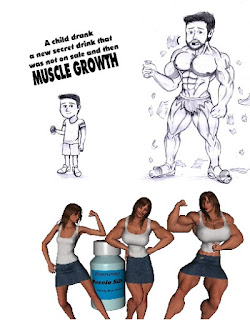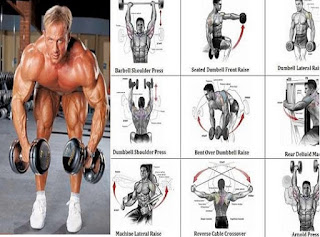How Do Muscles Grow?
If you’re a guy in the gym working with weights, not only are you probably trying to lose some fat, but also gain some muscle.
When someone like a powerlifter is able to lift very heavy weight despite not looking very muscular, it’s due to their ability to activate those motor neurons and contract their muscles better. This is why some powerlifters can be relatively smaller compared to bodybuilders, but can lift significantly more weight. Motor Unit recruitment also helps to explain why, after practice, certain movements become easier to perform and most of the initial strength gains will be when you first start to lift weights. Muscle growth tends to occur more steadily after this initial period of strength gain because you are more easily able to activate the muscles.
What Causes Muscle Growth?
In order for muscles to grow, three things are required:
1. Stimulus - exercise is needed to make the muscles work, use energy and cause microscopic damage to the fibers.
2. Nutrition - after intense exercise the muscles need to replenish their stores of fuel.
3. Rest - it is during the rest or recovery phase that the muscles repair the microscopic damage and grow.
Muscle size increases due to hypertrophic adaptation and an increase in the cross section area of individual muscle fibers. Intensive exercise impacts more on the strength influencing fast twitch type II fibers, therefore the increase in muscle size is accompanied by greater strength.
This will deplete the muscle's energy stores and cause microscopic damage to the muscle tissue. During recovery, these stores of glycogen and phosphocreatine will replenish from carbohydrates and creatine ingested as food or supplements. Amino acids supplied in the diet will trigger the protein synthesis that repairs the damaged muscle and lead to the creation of bigger muscle fibers.
To achieve continuous improvement you will need to keep reaching for higher levels of training intensity otherwise the improvement process will grind to a halt. Fortunately, this is relatively easy to plan for provided certain basic principles and rules are clearly followed.
3 Mechanisms That Make Muscles Grow
Underlying all progression of natural muscle growth is the ability to continually put more stress on the muscles. This stress is a major component involved in the growth of a muscle and disrupts homeostasis within your body. The stress and subsequent disruption in homeostasis causes three main mechanisms that spur on muscle growth.
1. Muscle Tension
In order to produce muscle growth, you have to apply a load of stress greater than what your body or muscles had previously adapted too. How do you do this? The main way is to lift progressively heavier weights. This additional tension on the muscle helps to cause changes in the chemistry of the muscle, allowing for growth factors that include mTOR activation and satellite cell activation.3
Muscular tension also most dramatically effects the connection of the motor units with the muscle cells. Two other factors help to explain why some people can be stronger, but not as big as other people.
2. Muscle Damage
If you’ve ever felt sore after a workout, you have experienced the localized muscle damage from working out. This local muscle damage causes a release of inflammatory molecules and immune system cells that activate satellite cells to jump into action. This doesn’t mean that you have to feel sore in order for this to happen, but instead that the damage from the workout has to be present in your muscle cells. Typically soreness is attenuated over time by other mechanisms.
3. Metabolic Stress
If you’ve ever felt the burn of an exercise or had the “pump” in the gym, then you’ve felt the effects of metabolic stress. Scientists used to question bodybuilders when they said the “pump” caused their muscles to become larger. After more investigation, it seems as though they were onto something.
Metabolic stress causes cell swelling around the muscle, which helps to contribute to muscle growth without necessarily increasing the size of the muscle cells. This is from the addition of muscle glycogen, which helps to swell the muscle along with connective tissue growth. This type of growth is known as sarcoplasmic hypertrophy and is one of the ways that people can get the appearance of larger muscles without increases in strength.
When someone like a powerlifter is able to lift very heavy weight despite not looking very muscular, it’s due to their ability to activate those motor neurons and contract their muscles better. This is why some powerlifters can be relatively smaller compared to bodybuilders, but can lift significantly more weight. Motor Unit recruitment also helps to explain why, after practice, certain movements become easier to perform and most of the initial strength gains will be when you first start to lift weights. Muscle growth tends to occur more steadily after this initial period of strength gain because you are more easily able to activate the muscles.
What Causes Muscle Growth?
In order for muscles to grow, three things are required:
1. Stimulus - exercise is needed to make the muscles work, use energy and cause microscopic damage to the fibers.
2. Nutrition - after intense exercise the muscles need to replenish their stores of fuel.
3. Rest - it is during the rest or recovery phase that the muscles repair the microscopic damage and grow.
Muscle size increases due to hypertrophic adaptation and an increase in the cross section area of individual muscle fibers. Intensive exercise impacts more on the strength influencing fast twitch type II fibers, therefore the increase in muscle size is accompanied by greater strength.
This will deplete the muscle's energy stores and cause microscopic damage to the muscle tissue. During recovery, these stores of glycogen and phosphocreatine will replenish from carbohydrates and creatine ingested as food or supplements. Amino acids supplied in the diet will trigger the protein synthesis that repairs the damaged muscle and lead to the creation of bigger muscle fibers.
To achieve continuous improvement you will need to keep reaching for higher levels of training intensity otherwise the improvement process will grind to a halt. Fortunately, this is relatively easy to plan for provided certain basic principles and rules are clearly followed.
3 Mechanisms That Make Muscles Grow
Underlying all progression of natural muscle growth is the ability to continually put more stress on the muscles. This stress is a major component involved in the growth of a muscle and disrupts homeostasis within your body. The stress and subsequent disruption in homeostasis causes three main mechanisms that spur on muscle growth.
1. Muscle Tension
In order to produce muscle growth, you have to apply a load of stress greater than what your body or muscles had previously adapted too. How do you do this? The main way is to lift progressively heavier weights. This additional tension on the muscle helps to cause changes in the chemistry of the muscle, allowing for growth factors that include mTOR activation and satellite cell activation.3
Muscular tension also most dramatically effects the connection of the motor units with the muscle cells. Two other factors help to explain why some people can be stronger, but not as big as other people.
2. Muscle Damage
If you’ve ever felt sore after a workout, you have experienced the localized muscle damage from working out. This local muscle damage causes a release of inflammatory molecules and immune system cells that activate satellite cells to jump into action. This doesn’t mean that you have to feel sore in order for this to happen, but instead that the damage from the workout has to be present in your muscle cells. Typically soreness is attenuated over time by other mechanisms.
3. Metabolic Stress
If you’ve ever felt the burn of an exercise or had the “pump” in the gym, then you’ve felt the effects of metabolic stress. Scientists used to question bodybuilders when they said the “pump” caused their muscles to become larger. After more investigation, it seems as though they were onto something.
Metabolic stress causes cell swelling around the muscle, which helps to contribute to muscle growth without necessarily increasing the size of the muscle cells. This is from the addition of muscle glycogen, which helps to swell the muscle along with connective tissue growth. This type of growth is known as sarcoplasmic hypertrophy and is one of the ways that people can get the appearance of larger muscles without increases in strength.




Commentaires
Enregistrer un commentaire